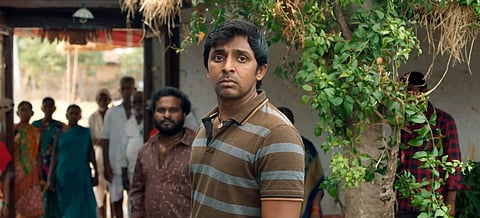Balagam Movie Review: A beautiful exploration of culture and human condition
Rating:(4 / 5)
Having watched films like Karnan, Garuda Gamana Vrishabha Vahana, and Angamaly Diaries, I have always yearned for Telugu films to portray and celebrate our culture. My wish has been fulfilled with Balagam. It not only represents the customs of Telangana authentically but is entirely centred on the culture.
Starring: Priyadarshi, Kavya Kalyanram
Directed by: Venu Yeldandi
For instance, we know that the interval point of any film is utilised to pronounce the central conflict of the story, and in Balagam, the interval point is built around the custom of offering a feast to the soul of the dead. When a crow doesn’t eat it, it is believed that the dead are yet to find peace, and naturally, it’s not considered to be a good sign. So the family of the deceased patriarch, Komurayya (Sudhakar Reddy, a wonderful find), make the offering and wait for a crow to come down and have it. When it doesn't happen, it creates emotional unrest--backed by quarrels in the past and egos--among them. And this conflict around the tradition transforms into the film's core narrative; on one level, it is about the custom and on another level, it is about the people harbouring custom.
Balagam even looks at these people through the lenses of culture, their egos, and flaws. That apart, their personalities stand as reflections of their responses to everything that happens at a funeral. The detailed portrayal is astounding. Also, the song that captures the last rites of Komurayya, which begins as a celebration and ends in mourning, is effectively shot.
Two characters at opposing end challenge to throw a bigger feast than the other. The bigger the feast, the larger the number of goats required. Minutes into the film, we get a fair idea about the jaunty Komurayya as he nonchalantly goes on with his day, flirting with women of different ages and interacting with the members of the close-knit community of his village.
The following scene sets up the sturdy character of Komurayya’s angry elder son Aillayya (Jayram, again, great find) and then his grandson, the ambitious yet unsuccessful Sayilu (a perfectly cast Priyadarshi). Many of Sayilu’s business plans have failed. His external conflict is to repay the load. And even when he learns about his grandfather’s untimely demise, he is more concerned about the possible delay of the engagement with his girlfriend and, consequently, receiving the dowry money. The internal conflict is that he is selfishly materialistic at times of great loss. The moment he realises his selfishness and wrongdoings is heart-wrenching, and Priyadarshi has effectively portrayed the role.
One of the fascinating aspects of the film is that almost everyone here is grey, but it doesn’t manipulate you to hate or empathise with any particular character. In fact, it only rightly calls them out for their mistakes and misplaced priorities.
Despite the despair in its atmosphere—considering the story takes place in a span of 11 days through a funeral—the film finds humour in many odd ways. From a woman crying persistently to another woman feigning sadness, many such rooted instances show the filmmaker drawing inspiration from lived-in experiences.
Balagam is not infallible, though, and it comes with its own set of flaws. The screenplay gets stuck in a tedium of repetitive scenes towards the end. Likewise, when Sayilu breaks into a dance in the otherwise fun ‘Potti Pilla’, you wonder why this character that has been so realistic until that point is suddenly behaving like he’s in a Telugu film. However, it lasts only a short while. This reminds me of a beautiful line in the song that goes, ‘Kallulotti pakkana kaarappoosa lekka mana jodi mastuntade (Our pairing is as good as a spicy sev and palm wine)’. The film’s love for the lifestyle it portrays keeps popping up in distinct ways.
The film also doesn't try to get too inventive with its craft, with the staging and cinematography, despite running the risk of being called too simplistic, serve the story well, although I wish it had played more with the visuals instead of relying much on the dialogues. Meanwhile, the dialogues are the lifeline of the film and they do a wonderful job capturing the life of the Telangana region.
While Venu Yeldandi paints a beautiful portrait, it’s Bheems Ceciroleo who gives it life with his music. Especially, his collaboration with folk musicians for one particular music piece that sums up the entirety of the film and the character arcs, in the end, is noteworthy. This sequence represents the confluence of two of Balagam’s traits: its urge to preach the importance of relationships and its love for the Telangana culture. And one shot in which we see the hands of this family placed one above the other, as they reach the final stage of the funeral, will be etched in my memory for a long time. It is the image Balagam stood for.


